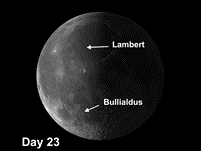The week of August 30 – September 5 takes us from Lunar Day 22 to Day 28.
 This week we will highlight the moon crater Bullialdus and the ghost crater Lambert-R, immediately above the moon crater Lambert, both viewable around 1:00 a.m. on Tuesday morning.
This week we will highlight the moon crater Bullialdus and the ghost crater Lambert-R, immediately above the moon crater Lambert, both viewable around 1:00 a.m. on Tuesday morning.
Lambert-R: [NW/G7] Immediately south of the moon crater Lambert you will see what is called a “ghost crater,” which is a circular wrinkle ridge formation indicating an underlying crater that had been completely inundated by the Imbrium lava flows. As the lava cooled, it shrank and the outline of the original crater rim percolated to the top, leaving a ghostly imprint of the original crater.
 Bullialdus: [SW/M7] If you recall what Tycho looked like last night (and there may be enough features left tonight to remind you), Bullialdus shares much of the same morphology in spite of being only half the size: a compound central mountain, eye-catching terraces, a flat floor, a thick ejecta blanket, and material in the immediate environs that rained back down after impact. There are so many interesting features that it is surprising that Bullialdus gets such short shrift. It is the most conspicuous crater on Mare Nubium, an area that offers several conversation pieces. Examine the inner terraces for tiny impact craters and evidence of landslides. Can you make out an intriguing raised ridge running from the central mountains southeast to the base of the terraces on the wall? Over the next few nights, observe how the appearance of the central mountains changes substantially.
Bullialdus: [SW/M7] If you recall what Tycho looked like last night (and there may be enough features left tonight to remind you), Bullialdus shares much of the same morphology in spite of being only half the size: a compound central mountain, eye-catching terraces, a flat floor, a thick ejecta blanket, and material in the immediate environs that rained back down after impact. There are so many interesting features that it is surprising that Bullialdus gets such short shrift. It is the most conspicuous crater on Mare Nubium, an area that offers several conversation pieces. Examine the inner terraces for tiny impact craters and evidence of landslides. Can you make out an intriguing raised ridge running from the central mountains southeast to the base of the terraces on the wall? Over the next few nights, observe how the appearance of the central mountains changes substantially.
The floor of Bullialdus creates a small illusion; as a result, there is some disagreement about its shape. Some observers think it is concave, others (most notably Patrick Moore, of Caldwell Object fame) think it is convex. How does it strike you?
Look carefully at the shared terrain between Bullialdus and Bullialdus A immediately to its south. Other than the fact that Bullialdus A is smaller, can you see any evidence that tells you which crater is older? 1
1 Bullialdus A has landed within the already formed ramparts of Bullialdus, making it younger. Also, the mere fact that it is smaller usually means it is also younger.
======================
It is highly recommended that you get a copy of Sky and Telescope’s Field Map of the Moon, the very finest Moon map available for use at the telescope. It is available for $10.95 at www.skyandtelescope.com and on Amazon. All features mentioned in this blog will be keyed to the grid on the Field Map and will look like this: Plato: [NW/D9]
Credits:
Courtesy of Gray Photography of Corpus Christi, Texas
Lunar photos: NASA / USGS / BMDO / LROC / ASU / DLR / LOLA / Moon Globe. Used by permission
- Rupes Cauchy: A Best Known Fault on the Moon - July 22, 2024
- Moon Crater Schickard – Crater Floor has Stripes - July 15, 2024
- Moon Craters Langrenus and Vandelinus - July 8, 2024